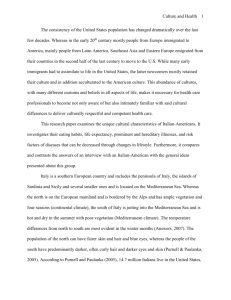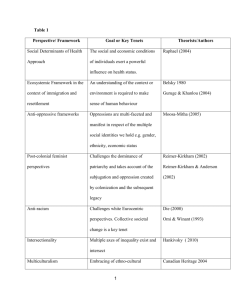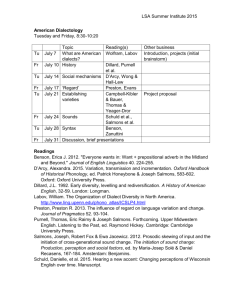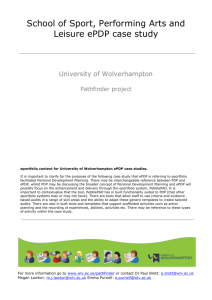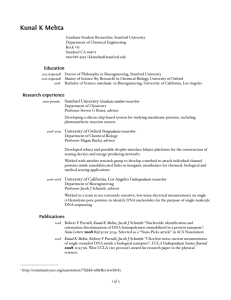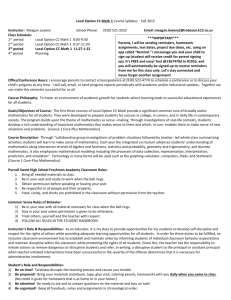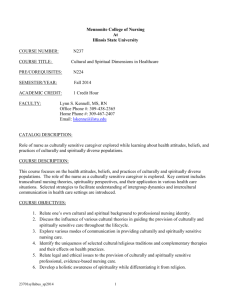Cultural Theories and Models - Transcultural Nursing Society
advertisement
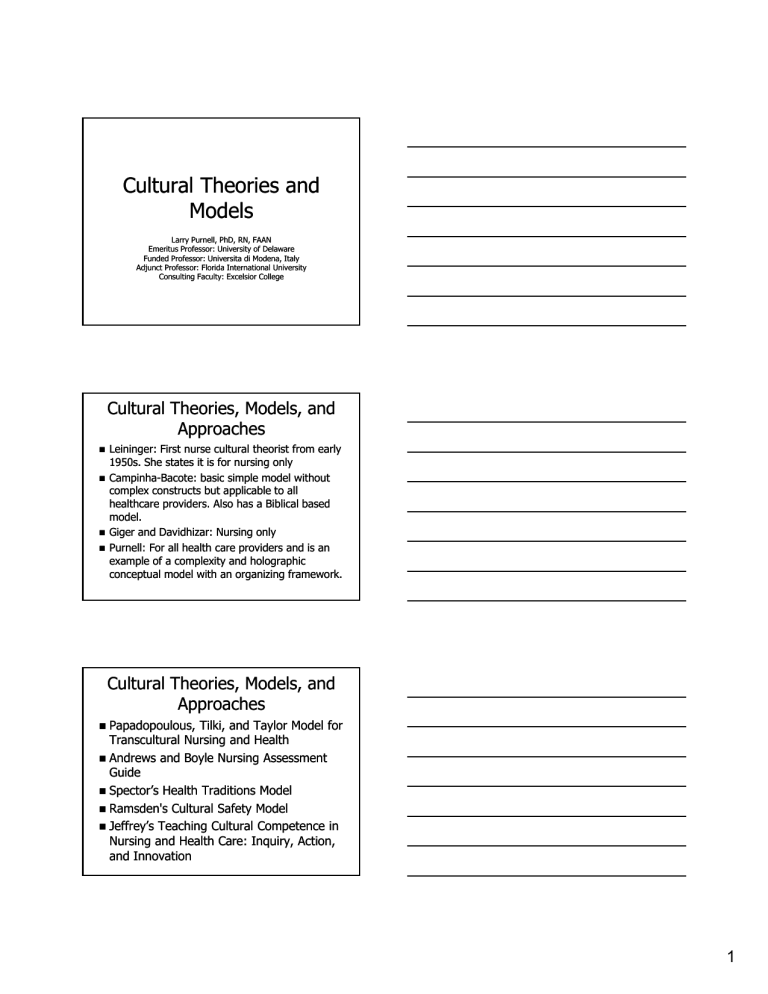
Cultural Theories and Models Larry Purnell, PhD, RN, FAAN Emeritus Professor: University of Delaware Funded Professor: Universita di Modena, Italy Adjunct Professor: Florida International University Consulting Faculty: Excelsior College Cultural Theories, Models, and Approaches Leininger: First nurse cultural theorist from early Leininger: 1950s. She states it is for nursing only Campinha--Bacote: Campinha Bacote: basic simple model without p constructs but applicable pp to all complex healthcare providers. Also has a Biblical based model. Giger and Davidhizar: Davidhizar: Nursing only Purnell: For all health care providers and is an example of a complexity and holographic conceptual model with an organizing framework. Cultural Theories, Models, and Approaches Papadopoulous,, Tilki Papadopoulous Tilki,, and Taylor Model for Transcultural Nursing and Health Andrews and Boyle Nursing Assessment Guide Spector’s Health Traditions Model Ramsden's Cultural Safety Model Jeffrey’s Teaching Cultural Competence in Nursing and Health Care: Inquiry, Action, and Innovation 1 Leininger’s Theory of Cultural Care Diversity and Universality Culture Care Theory www.madeleine--leininger.com www.madeleine Leininger described the phenomena of cultural care based on her experiences. Began in the 1950s with her doctoral dissertation conducted in New Guinea www.tcns.org and go to theories and then to the Sunrise Enabler and her model is displayed as well as publications. Transcultural Nursing "Transcultural nursing has been defined as a formal area of study and practice focused on comparative humanhuman-care (caring) differences and similarities of the beliefs, values, and patterned lifeways of cultures to provide culturally congruent, meaningful, and beneficial health care to people.“ Leininger and McFarland text, 3rd ed.,2002, pp5 pp5--6. 2 Leninger:: Purpose and Goal Leninger To discover, document, interpret, explain and predict multiple factors influencing care from a cultural holistic perspective. The g goal of the theoryy was to provide p culturally congruent care that would contribute to the health and well being of people, or to help them face disability, dying, or death using the three modes of action. Leninger:: Theoretical Tenets Leninger Leininger’s tenets: Care diversities (differences) and universalities (commonalties) existed among cultures in the world which needed to be discovered, discovered and analyzed for their meaning and uses to establish a body of transcultural nursing knowledge. Leininger:: Assumptions Leininger Care is essence of nursing and a distinct, dominant, central, and unifying focus. Some would say that caring is not unique to nursing. Care is essential for well being, g, health,, growth, g , survival, and to face handicaps or death. Culturally based care is the broadest means to know, explain, interpret, and predict nursing care phenomena to guide nursing care decisions and actions. 3 Leininger Assumptions Nursing is a transcultural humanistic and scientific care to serve individuals, groups, communities, and institutions worldwide. Caring g is essential to curing g and healing g for there can be no curing without caring. Cultural care concepts meanings and expression patterns of care vary transculturally with diversity and universality. Leininger Assumptions Every human culture has generic care knowledge and practices and some professional care knowledge that vary transculturally. Culture care values, beliefs, and practices are influenced by the (rays of the sun see the Model). Beneficial, healthy, and satisfying culturally based care influences the health and wellwell-being of individuals, families, groups, and communities within the cultural context. Leininger Assumptions Culturally congruent care can only occur when individuals’, groups’, and communities’ patterns are known and used in meaningful ways. Culture care differences and similarities between professionals and clients exist in all human cultures worldwide. Culture conflicts, imposition practices, cultural stresses, and pain reflect the lack of professional care to provide culturally congruent care. 4 Leininger Orientational Theory Definitions Cultural Care Preservation or Maintenance: all is well with the patient so encourage to continue what has been done Cultural Care Accommodation or Negotiation: Needs some change change. What is acceptable weight from the patient’s perspective Cultural Care Repatterning or Restructuring: Practices are deleterious to overall health and need restructured: sexually promiscuous and has not been practicing safe sex Cultural Competence in the Delivery of Healthcare Services: A culturally Competent p Model of Care Dr. Josepha Campinha Campinha--Bacote but cannot display her model. Go to http://www.transculturalcare.net 5 Process of Cultural Competence Cultural Competence is a process not an event. The process consist of five interinter-related constructs: Cultural desire, cultural awareness, cultural knowledge, cultural skills, and cultural encounter. The key and pivotal construct is cultural desire. There is more variation within a cultural group than across cultural groups. There is a direct relationship between healthcare professionals level of cultural competence and their ability to provide culturally responsive health care. Cultural competence is an essential component in delivering effective and culturally responsive care to culturally diverse clients. Cultural Desire . . . Cultural desire is defined as the motivation of the healthcare professional to “want to” engage in the process of becoming culturally competent; not the “have to”. Cultural Awareness Cultural awareness is the selfself-examination and inin-depth exploration of one’s own cultural background. 6 Cultural Knowledge Cultural knowledge is the process of seeking and obtaining a sound educational base about culturally diverse groups. Cultural Skills Cultural Skills is the ability to collect relevant cultural data regarding the client’s presenting problem as well as accurately perform a culturally based physical assessment. Cultural Encounter Cultural encounter is the process which encourages the healthcare professional to directly engage in faceface-to to--face interactions with clients from culturally diverse backgrounds. 7 The Giger and Davidhizar Transcultural Assessment Model Dr. Joyce Giger Dr. Ruth Davidhizar (deceased) Giger and Davidhizar Assumptions The Giger and Davidhizar Transcultural Model postulates that each individual is culturally unique and should be assessed according to the six cultural phenomena phenomena. Giger and Davidhizar Communication Communication embraces the entire world of human interaction and behavior. Communication is the means by which culture is transmitted and preserved. preserved Both verbal and nonnon-verbal communication are learned in one’s culture. 8 Giger and Davidhizar Space Space refers to the distance between individuals when they interact. All communication occurs in the context of space. space Zones of personal space: intimate, personal, social, and consultative and public. Rules concerning personal distance vary from culture to culture. Giger and Davidhizar Social Organization Social organization refers to the manner in which a cultural group organizes itself around the family group. Family structure and organization, organization religious values and beliefs, and role assignments may all relate to ethnicity and culture. Giger and Davidhizar Time Time is an important aspect of interpersonal communication. Cultural groups can be past, present, or future oriented Preventive health requires some oriented. future time orientation because preventative actions are motivated by a future reward. 9 Giger and Davidhizar Environmental Control Environmental control refers to the ability of the person to control nature and to plan and direct factors in the environment that affect them them. Giger and Davidhizar Biological variations Biological differences, especially genetic variations, exist between individuals in different racial groups. Boyle and Andrews Culturological Assessment Biocultural variations and cultural aspects of the incidence of disease Communication Cultural C lt l affiliations ffili ti Cultural sanctions and restrictions Developmental considerations Economics Educational background 10 Boyle and Andrews Culturological Assessment Health related beliefs and practices Kinship and social networks Nutrition Religion and spirituality Values orientation Ramsden Cultural Safety "the effective nursing practice of a person or a family from another culture, as determined by that person or family", while unsafe cultural practice is "any any action which diminishes, demeans or disempowers the cultural identity and wellbeing of an individual" (Nursing Council of New Zealand (NCNZ), Ramsden Cultural Safety http://culturalsafety.massey.ac.nz/RAMSDEN%20THESIS.pdf Assumes that nurses and the culture of nursing is exotic to people Gives the power of definition to the person served Concerned with human diversity Focus internal on nurse or midwife, exchanges power, negotiated A key part of Cultural Safety is that it emphasises life chances rather than life styles 11 Papadopoulos, Tilki Tilki,, and Taylor Cultural Awareness Self awareness Cultural identity Heritage adherence Ethnocentricity Stereotyping Ethnohistory Papadopoulos, Tilki, Tilki, and Taylor Cultural Knowldege Health beliefs and behaviours Anthropological, Sociological, Psychological and Biological understanding Similarities and differences Health Inequalities Papadopoulos, Tilki, Tilki, and Taylor Cultural Sensitivity Empathy Interpersonal/communication skills Trust Acceptance Appropriateness Respect 12 Papadopoulos, Tilki, Tilki, and Taylor Cultural Competence Assessment skills Diagnostic skills Clinical Skills Challenging and addressing prejudice, discrimination, and inequalities The Purnell Model for Cultural Competence p Larry Purnell, PhD, RN, FAAN Emeritus Professor: University of Delaware Adjunct Professor: Florida International University Consulting Faculty: Excelsior College Purnell: Cultural Competence Having the skills, knowledge, and understanding about another culture that allows to healthcare provider to assess and intervene in a culturally acceptable manner. Knowledge about a diverse culture means you know what questions to ask. 13 Purnell: Cultural Competence Developing an awareness of one’s own existence, sensations, thoughts, and environment without letting it have an undue influence on those from other backgrounds. Accepting and respecting cultural differences. Purnell: Culture Defined The totality of socially transmitted behavior patterns, arts, beliefs, values, customs, lifeways, and all other products of human work and thought characteristics of a populations that guides its worldview and decision making. These patterns may be explicit or implicit, are primarily learned and transmitted within the family, and are shared by the majority of the population. Purnell: Race Has to do with the physical and biological variations such as skin color, blood type, eye color, etc.: Traits that are transmitted genetically. genetically Race has social meaning, assigns status, limits opportunities, and influences interactions between patients and clinicians. 14 Purnell: Basic Assumptions All healthcare professions need much of the same information about cultural diversity One culture is not better than another culture, theyy are jjust different There are core similarities shared by all cultures Cultures change over time – slowly but with the world wide web change is accelerating in ways it never has before. Purnell: Basic Assumptions There are differences within, among, and between cultures The primary and secondary characteristics of culture determine the degree to which one varies from his/her dominant culture group. More on this later. The more you know about a cultural group, the better questions you can ask. Purnell: Basic Assumptions If clients are coco-participants in care and have a choice in healthhealth -related goals, plans, and interventions, health outcomes will be improved. Culture has powerful influence on one's interpretation of and responses to health care Individuals and families belong to several cultural groups. 15 Purnell: Basic Assumptions Each individual has the right to be respected for his/her uniqueness and cultural heritage. Caregivers i need both cultural general and culture specific information in order to provide culturally sensitive and culturally competent care. Aggregate data, beliefs, values and practices are true for the group, but not necessarily the individual. Purnell: Basic Assumptions Caregivers who can assess, plan, and intervene in a culturally competent manner will improve the care of clients for whom they care. Learning culture is an ongoing process and develops in a variety of ways, but primarily through cultural encounters Prejudices and biases can be minimized with cultural understanding Purnell: Basic Assumptions To be effective, health care must reflect the unique understanding of the values, beliefs, attitudes, lifeways and worldview of diverse lifeways, populations and individual acculturation patterns. Differences in race and culture require different interventions. Caregivers know themselves better by learning about their own cultures. 16 Purnell: Primary Characteristics Nationality: cannot change but people have changed their last names to fit into society Race: cannot change Color: cannot change Gender: Can change but may cause a stigma for the person or his/her family Age: cannot change but attempts to delay the aging process abound Religious Affiliation: can change but may cause a stigma for the person or his/her family – change from Judaism to Catholicism Purnell: Secondary Characteristics All are subject to change = change in worldview Educational status Socioeconomic status Occupation Military experience Political beliefs Urban versus rural residence Marital status Purnell: Secondary Characteristics Parental status Physical characteristics Sexual orientation Gender Issues Reason for immigration - sojourner, immigrant, undocumented status 17 Purnell: Communication Language and dialects: Spanish is not Spanish is not Spanish. English is not English is not English Contextual use of the language: number or words used to express a thought Touch and spatial p distancing: g familyy and friends versus acquaintances and strangers Eye contact: maintain or not maintain which is culture bound Time and temporality: how punctual are people in formal and informal settings? Greetings: Always be for formal until told to do othewise. Purnell: Communication Touch: observe how comfortable the patient is with touch from the same and opposite gender; even ask them. Take cues from the patient, e.g. an orthodox male may may extend his hand for a greeting or stand with his hands in his pockets so as to not touch a female Observe how easily the patient shares his/her feelings, thoughts, and ideas with the caregiver. The caregiver may have to make very specific comments and ask if the patient shares the ideas, thoughts, etc. 18 Purnell: Communications Take cues as the the proper distance in conversing with the patient. Do not take offense if the patient stands closer to you or farther away than you would like. Observe facial expressions and other gestures gestures. Not all individuals are expressive with facial expressions and gesturing; others may be very expressive. Observe for eye contact: Just because someone does not maintain eye contact does not mean he/she is not listening Purnell: Communications Just because someone maintains intense direct eye contact does not necessarily mean aggression or anger. Take cues from yyour p patient when greeting g g him/her. Do not become offended if a hand is not extended to greet the caregiver. Ask the patient if he/she is usually on time for work or health appointments versus on time for social engagements. Purnell: Communications Voice volume varies by culture and gender. A loud voice volume does not always indicate anger g or excitement. A low voice volume does not necessarily mean that the person is shy. Some people have several names. Specifically ask which is the family name, which is the given name, and if they have other names. What is your legal name? 19 Purnell: Working with Interpreters Use dialectdialect-specific interpreters whenever possible Use interpreters trained in the healthcare field Give the interpreter time to be alone with the patient Social class differences between the interpreter and client may result in the interpreter’s not reporting information that he or she perceives as superstitious or important Purnell: Working with Interpreters Provide time for translation and interpretation Be aware that interpreters may affect the reporting of symptoms, symptoms insert their own ideas, or omit information Avoid the use of relatives who may distort information or not be objective Purnell: Working with Interpreters Avoid using children as interpreters, especially with sensitive topics Use same same--age or older interpreters whenever p possible Use same same--gender interpreters whenever possible Maintain eye contact with both the client and interpreter to elicit feedback and read nonverbal cues 20 Purnell: Working with Interpreters Most clients can understand more than they can express Are alert to healthcare providers language Speak S k slowly l l and d in i a normall tone t off voice i without exaggerated mouthing Use as many words as possible in the patient’s language Purnell: Family Roles and Organization Decision-making: Who in the family makes Decisionmost of the decisions? Who makes the decisions about health care? Purnell: who gives the Remember: the person answer many not necessarily be the person who makes the decision. Thus, the spokesperson may be different from the decision maker Purnell: Family Roles and Organization What are the duties for women in your household? What are the duties of men in your household? What are the duties of children, teenagers, young adult in your household? Do they help with household chores? What should children do to make a good impression for themselves and for the family? 21 Purnell: Family Roles and Organization What should teenagers do to make a good impression for themselves and for the family? In your family family, what should a child/teenager not do to make a good impression for themselves or their family? In your family, what are children /teenagers forbidden to do? Purnell: Family Roles and Organization Are there extended family members in your household? In your family, is it acceptable for young adults g married? to have children with being Is it acceptable for adults to live together and not be married? Is divorce acceptable in your family? Is there a stigma? Do you have an intimate physical relationship with someone of the same sex? Purnell: Biocultural Ecology With what race do you identify? Different techniques used for oxygenation, rashes, sunburn according to skin color Differences Diff exist i t between b t races iin terms t of bone density, pelvic structure, eye color, nose bridge, size of teeth, etc. Asians, African Americans, etc. 22 Purnell: Biocultural Ecology Are you allergic to any medicines?foods? Metabolic differences exist between races; e.g. lactose intolerance, fava bean allergy, salt dependent hypertension hypertension, alcohol metabolism, psychotropics, etc. What health conditions exist in your family: breast cancer, CV disorders, etc. Purnell: Biocultural Ecology Health conditions vary according to topography and climate, so ask the patient about these situations Health disparities by cultural and racial groups Drug metabolism differs between races Purnell: Nutrition Which foods do you eat to maintain your health? Which foods do you avoid to maintain your health? Why do you avoid these foods? Which foods do you eat when you are ill? Which foods do you avoid when you are ill? 23 Purnell: Nutrition What foods do you eat to balance a meal? What foods do you eat every day? What foods do you eat every week? Which foods are high status foods in your culture? Which foods are eaten by men, by women, by children? Purnell: Nutrition Garm and sard (Iranian), am and dong (Vietnamese), yin and yang (Chinese), hot and cold – calor y frio (Spanish, fret and cho (Haitian), etc. How many meals do you eat each day? Who purchases the food in your family? Who prepares foods in the family? Do you eat food leftover from previous meals? Purnell: Nutrition Where do you keep your food? Do you have a refrigerator? How do you cook your food? Fry, broil, sauté, té etc. t How do you prepare your meat? Vegetables? Fry, broil, sauté, etc. What type of spices do you use? Do you drink special teas? 24 Purnell: Nutrition Are there preferred seating arrangement for meals in your home? Amish have an elaborate seating pattern – do you? Do y you have anyy food allergies? g How does your diet change with each season? How does your food habits differ on days you work versus days when you are not working? Purnell: Nutrition What time do you eat each meal? Can be quite different from the hospital. What foods do you eat when you snack? What Wh t foods f d do d you eatt ffor special i l holidays? Where do you usually buy your food? Purnell: Pregnancy and the Childbearing Family What kinds of birth control are acceptable to you? Is it acceptable in your culture for a man to have a vasectomy? What methods of increasing your chances for getting pregnant are acceptable for you? 25 Purnell: Pregnancy and the Childbearing Family What does it mean in your culture when a married woman becomes pregnant? What does it mean in your culture when an unmarried woman becomes p pregnant? g Do you satisfy your cravings for food or other substances while you are pregnant? What foods do you eat when you are pregnant? Purnell: Pregnancy and the Childbearing Family What foods you you avoid when you are pregnant? In your culture, what should women do to ensure having g a healthyy pregnancy p g y and delivering a healthy baby? In your culture, what should women not do to ensure having a healthy pregnancy and delivering a healthy baby? Purnell: Pregnancy and the Childbearing Family In your culture, what things are women prohibited from doing while they are pregnant to ensure having a healthy pregnancy and delivering a healthy baby? In what position do you prefer for delivering your baby? Who do you prefer having as a coach to assist you through childbirth? 26 Purnell: Pregnancy and the Childbearing Family What foods do you eat after childbirth to ensure your health and the health of your baby? What foods do you avoid after childbirth to to ensure your health and the health of your baby? Purnell: Pregnancy and the Childbearing Family What foods are prohibited after childbirth to ensure your health and the health of your baby? What things should you not do after childbirth to ensure your health and the health of your baby? Purnell: Pregnancy and the Childbearing Family What things should you do after childbirth to to ensure your health and the health of your baby? What things are prohibited after childbirth to to ensure your health and the health of your baby? 27 Purnell: Pregnancy and the Childbearing Family Who cares for the child after delivery? What do you do to take care of the cord? How long after delivery is it okay to b th ? bathe? How long after delivery is it okay to wash your hair? Purnell: Pregnancy and the Childbearing Family Do you prefer breastfeeding? What advantages does breastfeeding have for you? What Wh t disadvantages di d t does d breastfeeding b tf di have for you? Purnell: Death Rituals and Bereavement Do you want your body returned to your home country? Do you want interment or cremation? Who Wh do d you wantt to t b be att your b bedside d id when you are ill? Would you want to be told if you have a terminal illness? 28 Purnell: Death Rituals and Bereavement What do you expect family/friends to do when you die? Do you believe a person has the right to take his/her own life? Do you want to see a clergy member while you are in the hospital? Do you say prayers for your health? Purnell: Death Rituals and Bereavement What do you normally do to express your grief? How do men display grief in your culture? How H d do women di display l grief i f in i your culture? What happens to your body after you die? Do you believe in euthanasia? Purnell: Death Rituals and Bereavement What does “die with dignity” mean to you? Is there a particular color associated with death in your culture? Would you want to enter a hospice? Do you want to be pain free when you are dying? How long are people suppose to mourn in your culture. 29 Purnell: Spirituality With what religion do you identify? Does everyone in your household identify with the same religion? Do you consider yourself to be very religious? Is there a specific holy day which you observe? How often do you pray? Purnell: Spirituality Do you pray alone or in a group? Who is expected to stay with a family member when he/she is dying? What Wh t d do people l iin your culture lt do d when h someone is dying? What religious holidays do you celebrate? What diet does your religion require Purnell: Spirituality What is the most important thing in your life? Religion, family, health, money, etc. What gives you strength in your daily activities? 30 Purnell: Spirituality Do you pray for good health? Is there anything you need to say your prayers? What can I/we do to assist you with your religious/spirituality needs? Does your religion permit you to have a blood transfusion or receive blood products? Purnell: Spirituality Are you averse to having tests for genetic testing? Does the patient have religious books or objects in his/her possession or at the bedside? Does the patient wear any religious articles, clothing, or headdress? Purnell: Spirituality Does the patient receive greeting or get well cards of a religious nature? Does a religious person visit the patient? 31 Purnell: Healthcare Practices Do you have health insurance? Why not? Depends on the country but most countries with universal coverage has supplemental insurance available for those who can afford it. Who is responsible for your health needs, you, physicians, government, a family member? Do you consider yourself to be in good health? Purnell: Healthcare Practices What do you think is responsible for good health? What do you think is responsible for bad health? How do you feel about your weight? How do you maintain/reduce your weight? Purnell: Healthcare Practices What do you usually do when you have a minor illness? What do you do when you are very sick? What Wh t overover-the th - counter thet medicines di i do d you use? For what illnesses do you use them? Do you consider yourself mentally healthy? 32 Purnell: Healthcare Practices Do you see anyone for your mental health needs? Physician, nurse, priest, spiritualist, etc.? Do you have any chronic illnesses? What are your views on rehabilitation? What is expected of you and your family when you are ill? Purnell: Healthcare Practices Are blood transfusion or blood products acceptable to you if needed? Why not? Are you an organ donor? Are you averse to organ donation or organ transplantation? What other practices do you use to maintain your health? Acupuncture, massage, aromatherapy, etc.? Purnell: Healthcare Practitioners Do you have high regard for healthcare providers such as physicians, nurses other providers? So you use any healthcare providers besides physicians or nurses? Shamans, curanderos, spiritualists, etc. 33 Purnell: Healthcare Practitioners Do you object to a physical examination or receiving intimate care by someone of the opposite gender? What are the ideal qualities for a physician? What are the ideal qualities for a nurse? Purnell Resources Purnell, L., & Paulanka, B. (2008). Transcultural health care: A culturally competent approach. Philadelphia: F.A. Davis Co. Co Has 11 additional chapters on the web. Purnell, L. (2005). Guide to Culturally competent health care. Philadelphia: F.A. Davis Co. Purnell WEB Resources http://www.fadavis.com/online_store/catalog/catalog_detail.cfm?publication_id=2417 www.fadavis.com and enter Purnell in the search engine. Two books will be displayed. Click on the book and then click on DavisPlus. DavisPlus. Has student and instructor exam questions. Has extensive web recourses and links Had evidence evidence--based practice sites. Has a copy of the Purnell Model which can be downloaded – permission granted. 34 Resources From the Transcultural Nursing Society homePage www.tcns.org has descriptions of selected cultural theories and models. www.nursingtheory.net g y has many, y, manyy theories and models that include mid mid-range and grand theories of culture care. 35
